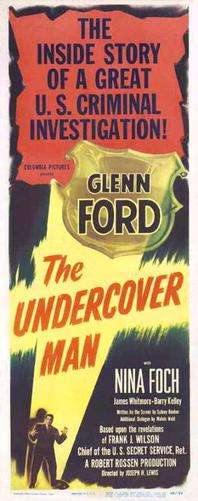The Undercover Man
The Undercover Man is a 1949 American crime drama film noir directed by Joseph H. Lewis and starring Glenn Ford, Nina Foch, and James Whitmore.[2]
| The Undercover Man | |
|---|---|
 Theatrical release poster | |
| Directed by | Joseph H. Lewis |
| Produced by | Robert Rossen |
| Screenplay by | Sydney Boehm Jack Rubin |
| Based on | article "Undercover Man: He Trapped Capone" by Frank J. Wilson |
| Starring | Glenn Ford Nina Foch James Whitmore |
| Music by | George Duning |
| Cinematography | Burnett Guffey |
| Edited by | Al Clark |
Production company | |
| Distributed by | Columbia Pictures |
Release date |
|
Running time | 84 minutes |
| Country | United States |
| Language | English |
| Box office | $1,950,000[1] |
Plot
Frank Warren is a treasury agent assigned to put an end to the activities of a powerful mob crime boss. The agent struggles to put together a case but is frustrated when all he finds are terrified witnesses and corrupt police officers. Although most informants end up dead, Agent Warren gets critical information about the mob from an unlikely source.
Cast
- Glenn Ford as Frank Warren
- Nina Foch as Judith Warren
- James Whitmore as George Pappas
- Barry Kelley as Edward O'Rourke
- David Bauer as Stanley Weinburg (as David Wolfe)
- Frank Tweddell as Insp. Herzog
- Howard St. John as Joseph S. Horan
- John Hamilton as Police Sergeant Shannon
- Leo Penn as Sidney Gordon
- Joan Lazer as Rosa Rocco
- Esther Minciotti as Maria Rocco
- Angela Clarke as Theresa Rocco
- Anthony Caruso as Salvatore Rocco
- Robert Osterloh as Manny Zanger
- Kay Medford as Gladys LaVerne
- Patricia Barry as Muriel Gordon (as Patricia White)
Background

The film was based on an article entitled "He Trapped Capone," the first part of the autobiography Undercover Man by Federal Agent Frank J. Wilson, which was serialized in Collier's in 1947.
Many details were fictionalized. The timeframe was changed from the Prohibition era to the postwar era. Chicago became an unnamed fairly-nondescript big city. Al Capone was referred to only as the shadowy "Big Fella" and photographed only from the rear and was a more diversified mobster rather than primarily a bootlegger (reflecting the change in US organized crime following Prohibition's repeal). Also, of course, IRS Criminal Investigator Frank Wilson became IRS Criminal Investigator Frank Warren.
Nevertheless, the film authentically portrayed the efforts of Wilson's team to put together a tax evasion case against Capone, and in many respects, despite the name changes and nondescript settings, the film is a far more accurate depiction of the investigation than later films on the same subject like The Untouchables.
For example, in The Untouchables the judge presiding over Capone's trial abruptly changes juries in the middle of the case, something that would never happen in real life. What actually happened was that the judge switched jury panels just before the trial began, and the incident is accurately portrayed in The Undercover Man.
Critical response
Bosley Crowther panned the film, writing, "Furthermore—and this is fatal—it is a drearily static film, for all its explosive flurries of gun-play and passing of violent threats. The big crisis in the picture comes when the Treasury man, played by Glenn Ford, is uncertain whether to stick with the case or retire to a farm. And the basis of his decision to go on sleuthing for Uncle Sam is a long-winded lecture on justice which a sad-eyed Italian woman gives. Mr. Ford, in a battered gray hat and a baggy suit, makes a pretty case for higher salaries to civil servants but a not very impressive sleuth. And James Whitmore, who played the sergeant in "Command Decision" on the stage, seems much more inclined to low clowning than to accounting as an assistant on the case. Barry Kelley is robustly arrogant as "the big fellow's" lawyer and front-man, with several other performers doing standard character roles."[3]
Yet, the staff at Variety magazine gave the film a positive review, and wrote, "Narrated in a straightforward, hardhitting documentary style, The Undercover Man is a good crime-busting saga. Standout features are the pic's sustained pace and its realistic quality. Fresh, natural dialog help to cover up the formula yarn, while topnotch performances down the line carry conviction. Joseph H. Lewis's direction also mutes the melodramatic elements but manages to keep the tension mounting through a series of violent episodes."[4]
Time Out film guide lauded the film and wrote, "A superior crime thriller in the semi-documentary style beloved by Hollywood in the late 1940s...[the film] achieves an authenticity rare in the genre. Perhaps even more impressive is the acknowledgment that mob crime affects not only cops and criminals, but innocents too: witnesses are silenced, bystanders injured. And Lewis - one of the B movie greats - directs in admirably forthright, muscular fashion, making superb use of Burnett Guffey's gritty monochrome camerawork."[5]
References
- "Top Grossers of 1949". Variety. 4 January 1950. p. 59.
- The Undercover Man on IMDb.
- Crowther, Bosley. The New York Times, film review, April 21, 1949. Last accessed: January 20, 2008.
- Variety. Film review, March 21, 1949. Last accessed: January 20, 2008.
- Time Out. Film review, 2006. Last accessed: January 20, 2008.